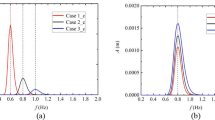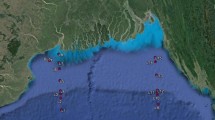Abstract
The coexistence of multiple wave systems generated locally and by remote storms is common in the ocean and its quantification is required in the design of marine facilities. This study identifies the multimodal sea states at six locations in the shelf seas of India based on partitioned wave output data from numerical model WAVEWATCH-III for 26 years (1990 to 2015). The different systems are identified by the propagation direction and frequencies with a relatively high probability of occurrence of spectral partitions. Four to seven types of distinct clusters of wave systems are present among the study locations. The occurrence of these systems and co-occurrence of this with other systems are examined. The southernmost location experiences the effect of seven wave systems. At all locations, two wave systems from the south with relatively low partial significant wave height (Hs) are present for more than 71% of the time and co-occurred with other systems during 2–67%. The most energetic systems are observed 23% (system 5 at station 3) to 60% (system 4 at station 4) of the time with maximum mean partial Hs values of 1 to 3 m during summer monsoon months. The southernmost location (3) experienced maximum opposing (18%) and crossing (78%) sea states.






Similar content being viewed by others
References
Aboobacker VM, Vethamony P, Rashmi R (2011) “Shamal” swells in the Arabian Sea and their influence along the west coast of India. Geophys Res Lett 38(3):L03608. https://doi.org/10.1029/2010GL045736
Amante C, Eakins B (2009) ETOPO1 1 arc-minute global relief model: procedures, data sources and analysis. NOAA Technical Memorandum NESDIS, NGDC-24, 19 pp
Amrutha MM, Kumar VS, Sandhya KG, Nair TMB, Rathod JL (2016) Wave hindcast studies using SWAN nested in WAVEWATCH III - comparison with measured nearshore buoy data off Karwar, eastern Arabian Sea. Ocean Eng 119C:114–124. https://doi.org/10.1016/j.oceaneng.2016.04.032
Anjali NM, Kumar VS (2016) Spectral wave climatology off Ratnagiri, northeast Arabian Sea. Nat Hazards 82:1565–1588. https://doi.org/10.1007/s11069-016-2257-5
Anjali NM, Kumar VS (2017) Wave spectral shapes in the coastal waters based on measured data off Karwar on the western coast of India. Ocean Sci 13:365–378. https://doi.org/10.5194/os-2016-91
Anoop TR, Kumar VS, Shanas PR, Glejin J, Amrutha MM (2016) Indian Ocean Dipole modulated wave climate of eastern Arabian Sea. Ocean Sci 12:369–378. https://doi.org/10.5194/osd-12-2473-2015
Anoop TR, Shanas PR, Aboobacker VM, Sanil Kumar V, Nair LS, Prasad R, Reji S (2020) On the generation and propagation of Makran swells in the Arabian Sea. Int J Climatol 40(1):585–593. https://doi.org/10.1002/joc.6192
Bitner-Gregersen EM, Toffoli A (2014) Occurrence of rogue sea states and consequences for marine structures. Ocean Dyn 64(10):1457–1468
Boukhanovsky AV, Soares CG (2009) Modelling of multipeaked directional wave spectra. Appl Ocean Res 31:132–141
Cavaleri L, Bertotti L, Torrisi L, Bitner-Gregersen E, Serio M, Onorato M (2012) Rogue waves in crossing seas: the Louis Majesty accident. J Geophys Res 117:C00J10. https://doi.org/10.1029/2012JC007923
Dattatri J, Raman H, Shankar NJ (1977) Comparison of Scott spectra with ocean wave spectra. Journal of the Waterway, Port, Coastal and Ocean Division 103:375–378
Echevarria ER, Hemer MA, Holbrook NJ (2019) Seasonal variability of the global spectral wind-wave climate. J Geophys Res Oceans 124:2924–2939. https://doi.org/10.1029/2018JC014620
Findlater J (1969) A major low-level air current near the Indian Ocean during the northern summer. Quart J Roy Meteor Soc 95(404):362–380. https://doi.org/10.1002/qj.49709540409
George J, Kumar VS (2020) Climatology of wave period in the Arabian Sea and its variability during the recent 40 years, Ocean Engineering 216: Article number 108014, https://doi.org/10.1016/j.oceaneng.2020.108014
Gerling TW (1992) Partitioning sequences and arrays of directional ocean wave spectra into component wave systems. J Atmos Ocean Technol 9(4):444–458
Goda Y (1992) Uncertainty of design parameters from viewpoint of extreme statistics. J Offshore Mech Arct 114(2):76–82
Hanson JL, Jensen RE (2004) Wave system diagnostics for numerical wave models. In: 8th International Workshop on Wave Hindcasting and Forecasting. Oahu, Hawaii, pp 231–238
Hanson JL, Phillips OM (2001) Automated analysis of ocean surface directional wave spectra. J Atmos Ocean Technol 18(2):277–293
Hersbach H, Dee D (2016) ERA5 reanalysis is in production. ECMWF Newsletter 2016, 147.7. https://www.ecmwf.int/en/newsletter/147/news/era5-reanalysis-production
Kumar VS, Kumar KA (2008) Spectral characteristics of high shallow water waves. Ocean Eng 35:900–911. https://doi.org/10.1016/j.oceaneng.2008.01.016
Kumar VS, Dubhashi KK, Nair TMB (2014) Spectral wave characteristics off Gangavaram, Bay of Bengal. J Oceanogr 70:307–321. https://doi.org/10.1007/s10872-014-0223-y
Liu Q, Babanin A, Fan Y, Zieger S, Guan C, Moon IJ (2017) Numerical simulations of ocean surface waves under hurricane conditions: assessment of existing model performance. Ocean Model 118:73–93
Narasimhan S, Deo MC (1979) Spectral analysis of ocean waves-a study. Proceedings of the conference on civil engineering in oceans, Vol 1, ASCE, New York, 877–892
Naseef TM, Sanil Kumar V (2020) Climatology and trends of the Indian Ocean surface waves based on 39-year long ERA-5 reanalysis data. Int J Climatol 40:979–1006. https://doi.org/10.1002/joc6251
Onorato M, Osborne AR, Serio M (2006) Modulational instability in crossing sea states: a possible mechanism for the formation of freak waves. Phys Rev Lett 96(1):014503
Portilla J (2018) Open Access Atlas of Global Spectral Wave conditions based on partitioning. Proceedings of the ASME 2018 37th International Conference on Ocean, Offshore and Arctic Engineering. Volume 11B: Honoring Symposium for Professor Carlos Guedes Soares on Marine Technology and Ocean Engineering. Madrid, Spain. June 17–22, 2018. V11BT12A051. ASME. https://doi.org/10.1115/OMAE2018-77230
Portilla J, Ocampo-Torres FJ, Monbaliu J (2009) Spectral partitioning and identification of wind sea and swell. J Atmos Ocean Technol 26(1):107–122
Seemanth M, Bhowmick SA, Kumar R, Sharma R (2016) Sensitivity analysis of dissipation parameterizations in a third-generation spectral wave model, WAVEWATCH III for Indian Ocean. Ocean Eng 124:252–273
Takbash A, Young IR (2019) Global ocean extreme wave heights from spatial ensemble data. J Clim 32:6823–6836
Taylor KE (2001) Summarizing multiple aspects of model performance in a single diagram. J Geophys Res-Atmos 106(D7):7183–7192
Toffoli A, Lefevre JM, Bitner-Gregersen E, Monbaliu J (2005) Towards the identification of warning criteria: analysis of a ship accident database. Appl Ocean Res 27(6):281–291
Toffoli A, Bitner-Gregersen EM, Osborne AR, Serio M, Monbaliu J, Onorato M (2011) Extreme waves in random crossing seas: laboratory experiments and numerical simulations. Geophys Res Lett 38:L06605. https://doi.org/10.1029/2011GL046827
Tolman HL (1991) A third-generation model for wind waves on slowly varying, unsteady and inhomogeneous depths and currents. J Phys Oceanogr 21:782–797
Tolman HL (2014) User manual and system documentation of WAVEWATCH III® version 4.18, NOAA Technical Note, MMAB Contribution No. 316
Trulsen K, Nieto Borge JC, Gramstad O, Aouf L, Lefèvre J-M (2015) Crossing sea state and rogue wave probability during the Prestige accident. J Geophys Res Oceans 120:7113–7136. https://doi.org/10.1002/2015JC011161
Umesh PA, Behera MR (2020) Performance evaluation of input-dissipation parameterizations in WAVEWATCH III and comparison of wave hindcast with nested WAVEWATCH III-SWAN in the Indian Seas. Ocean Engineering 202: article number 106959. https://doi.org/10.1016/j.oceaneng.2020.106959
Vincent L, Soille P (1991) Watersheds in digital spaces: an efficient algorithm based on immersion simulations. IEEE Transactions on Pattern Analysis & Machine Intelligence 6:583–598
Acknowledgements
The first author wishes to acknowledge CSIR for the award of Senior Research Fellowship. We acknowledge the Director, CSIR-NIO for the facilities provided to conduct this research. ERA5 wind data used in this study is obtained from the ECMWF data server: http://data.ecmwf.int/data. The authors thank the reviewers for the comments and suggestions, which improved the scientific content of the paper. This work is a part of the Doctoral thesis of the first author registered with Bharathidasan University, Tiruchirappalli and bears NIO contribution 6705.
Funding
This study was financially supported by the Council of Scientific & Industrial Research, New Delhi (CSIR).
Author information
Authors and Affiliations
Corresponding author
Additional information
Responsible Editor: Amin Chabchoub
Rights and permissions
About this article
Cite this article
Amrutha, M.M., Kumar, V.S. Identification of wave systems in the multimodal sea state along the Indian shelf seas. Ocean Dynamics 71, 589–600 (2021). https://doi.org/10.1007/s10236-021-01456-x
Received:
Accepted:
Published:
Issue Date:
DOI: https://doi.org/10.1007/s10236-021-01456-x




